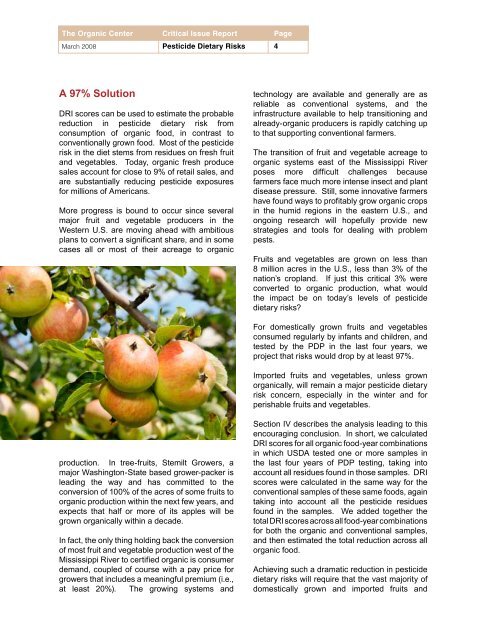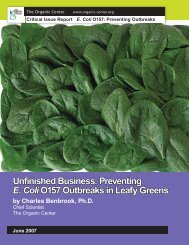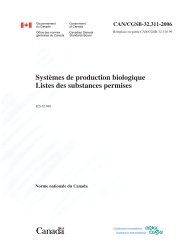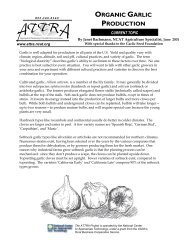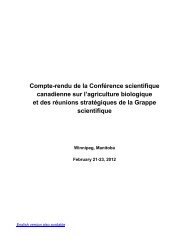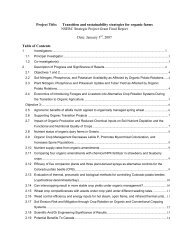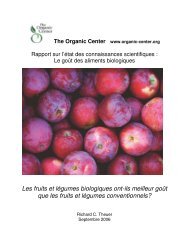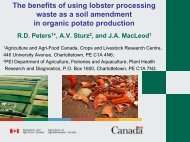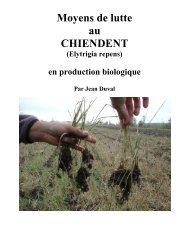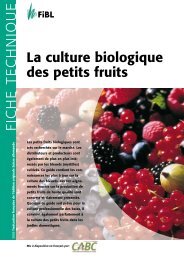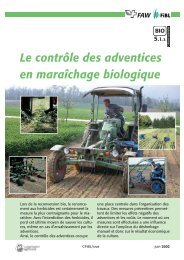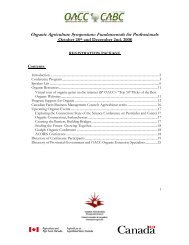The Organic Option - Centre d'agriculture biologique du Canada
The Organic Option - Centre d'agriculture biologique du Canada
The Organic Option - Centre d'agriculture biologique du Canada
You also want an ePaper? Increase the reach of your titles
YUMPU automatically turns print PDFs into web optimized ePapers that Google loves.
<strong>The</strong> <strong>Organic</strong> Center Critical Issue Report Page<br />
March 2008 Pesticide Dietary Risks 4<br />
A 97% Solution<br />
DRI scores can be used to estimate the probable<br />
re<strong>du</strong>ction in pesticide dietary risk from<br />
consumption of organic food, in contrast to<br />
conventionally grown food. Most of the pesticide<br />
risk in the diet stems from resi<strong>du</strong>es on fresh fruit<br />
and vegetables. Today, organic fresh pro<strong>du</strong>ce<br />
sales account for close to 9% of retail sales, and<br />
are substantially re<strong>du</strong>cing pesticide exposures<br />
for millions of Americans.<br />
More progress is bound to occur since several<br />
major fruit and vegetable pro<strong>du</strong>cers in the<br />
Western U.S. are moving ahead with ambitious<br />
plans to convert a significant share, and in some<br />
cases all or most of their acreage to organic<br />
technology are available and generally are as<br />
reliable as conventional systems, and the<br />
infrastructure available to help transitioning and<br />
already-organic pro<strong>du</strong>cers is rapidly catching up<br />
to that supporting conventional farmers.<br />
<strong>The</strong> transition of fruit and vegetable acreage to<br />
organic systems east of the Mississippi River<br />
poses more difficult challenges because<br />
farmers face much more intense insect and plant<br />
disease pressure. Still, some innovative farmers<br />
have found ways to profitably grow organic crops<br />
in the humid regions in the eastern U.S., and<br />
ongoing research will hopefully provide new<br />
strategies and tools for dealing with problem<br />
pests.<br />
Fruits and vegetables are grown on less than<br />
8 million acres in the U.S., less than 3% of the<br />
nation’s cropland. If just this critical 3% were<br />
converted to organic pro<strong>du</strong>ction, what would<br />
the impact be on today’s levels of pesticide<br />
dietary risks?<br />
For domestically grown fruits and vegetables<br />
consumed regularly by infants and children, and<br />
tested by the PDP in the last four years, we<br />
project that risks would drop by at least 97%.<br />
Imported fruits and vegetables, unless grown<br />
organically, will remain a major pesticide dietary<br />
risk concern, especially in the winter and for<br />
perishable fruits and vegetables.<br />
pro<strong>du</strong>ction. In tree-fruits, Stemilt Growers, a<br />
major Washington-State based grower-packer is<br />
leading the way and has committed to the<br />
conversion of 100% of the acres of some fruits to<br />
organic pro<strong>du</strong>ction within the next few years, and<br />
expects that half or more of its apples will be<br />
grown organically within a decade.<br />
In fact, the only thing holding back the conversion<br />
of most fruit and vegetable pro<strong>du</strong>ction west of the<br />
Mississippi River to certified organic is consumer<br />
demand, coupled of course with a pay price for<br />
growers that includes a meaningful premium (i.e.,<br />
at least 20%). <strong>The</strong> growing systems and<br />
Section IV describes the analysis leading to this<br />
encouraging conclusion. In short, we calculated<br />
DRI scores for all organic food-year combinations<br />
in which USDA tested one or more samples in<br />
the last four years of PDP testing, taking into<br />
account all resi<strong>du</strong>es found in those samples. DRI<br />
scores were calculated in the same way for the<br />
conventional samples of these same foods, again<br />
taking into account all the pesticide resi<strong>du</strong>es<br />
found in the samples. We added together the<br />
total DRI scores across all food-year combinations<br />
for both the organic and conventional samples,<br />
and then estimated the total re<strong>du</strong>ction across all<br />
organic food.<br />
Achieving such a dramatic re<strong>du</strong>ction in pesticide<br />
dietary risks will require that the vast majority of<br />
domestically grown and imported fruits and


